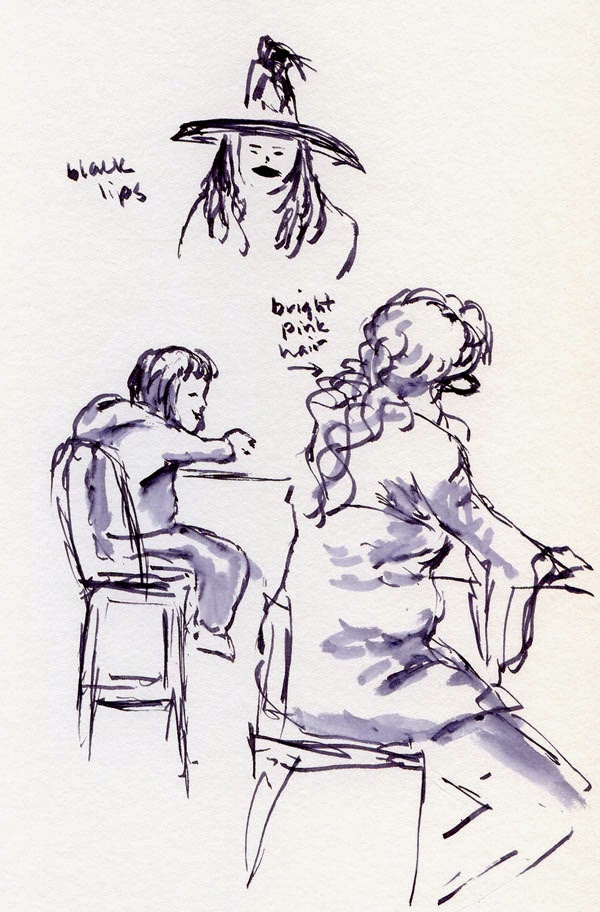 |
| 10/31/14 Diamine Eclipse ink, 1.5mm calligraphy nib, Caran d'Ache Museum colored pencil, Canson XL 140 lb. paper |
Whenever I sketch people out in the urban landscape, I can’t
resist the temptation to zero in on the nearest head and use my finest pen
point to carefully draw facial features as accurately as possible. I really
enjoy the challenge of trying to capture the delicate curve of a cheek, the
angle of an eyebrow or the sharp point of a nose in profile.
Those might be worthwhile goals for portraiture, but I’ve
learned from reading Thomas Thorspecken’s book, attending Melanie Reim’s Sketchbook Skool course,
and starting Veronica Lawlor’s SBS lesson
this morning that it’s the body – not the face – that tells a “story.” Body
language – posture, gesture, attitude – tells so much more about a person’s
mood, the type of conversation people are having or the stage of a relationship
than the expressions on their faces. Capturing body language – that’s my new
goal when sketching people.
Knowing how tempted I would be to pull out my favorite Sailor pen (whose nib, when
turned upside-down, has a very fine point), I went to Whole Foods’ café vowing
to use nothing but my Lamy with a 1.5mm calligraphy nib on it. Ideal for unruly tree branches, that nib would be
nearly impossible to sketch delicate facial details with. I knew I’d be forced
to focus on the larger “story” told by people’s bodies. And unlike at Zoka Coffee, where people tend to sit
motionlessly in front of laptops, Whole Foods’ patrons eat and run – often taking no more than five or 10 minutes
for their meals. I wouldn’t have the opportunity to slide leisurely down the
long ski slope of someone’s nose with my pen point.
 |
| 10/31/14 Diamine Eclipse ink, 1.5mm calligraphy nib, Caran d'Ache Museum colored pencil |
Today is Halloween, but you wouldn’t know it from most
of the clothes I sketched – it’s hoodie season again. Around 11 a.m., the
lunch bell must have rung at nearby Roosevelt High School, because dozens of
teenagers suddenly appeared in a rushed, giggling flurry of costumed hair and
makeup. I only managed to catch the witch with black lips, and then they all
disappeared as quickly as they came.
(I’m not sure whether the woman with the hot-pink hair was in costume or not. In Seattle, you can’t be too sure. But how’s that for resisting temptation? If I’d had my pink Zig marker, you can bet I would have colored it!)
 |
| 10/31/14 Diamine Eclipse ink, 1.5mm calligraphy nib |
 |
| 10/31/14 Diamine Eclipse ink, 1.5mm calligraphy nib |
 |
| 10/31/14 Diamine Eclipse ink, 1.5mm calligraphy nib |






































